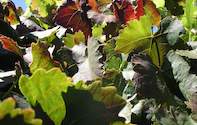Canopy management is the process where the vine shoots and leaves are managed in such a way that a good production of the right quality for the different types of wine is obtained. Reasons for canopy management are: To ensure that there is enough healthy leaves available.

Ensure that the leaves are exposed to sunlight and that there is not too much shade inside the vine. Ensure infertile shoots do not overgrow bearers. To stop the plant’s growth on time by means of tipping and topping so that all food and water firstly go to the bunch.
To ensure the wind blows through the shoots and leaves so that the leaves can dry quickly and do not get fungal diseases. For the vine’s leaves to photosynthesize properly, it needs to be exposed to sunlight.
If the canopy is too thick less sun gets to the inner leaves and this weakens their function. Yellow leaves on the inside are a sign of too little sunlight and this lowers the quality and production of the vineyard.
Good canopy management keeps the vines fruitful so that they can produce a good harvest every year. From November to December sunlight on the buds is very important to form a flower cluster for the following year’s harvest.
Efficient canopy management improve the micro-climate inside the vine. Enough light and air must be available as a dense vine stays wet longer and may develop more fungal diseases.
Ways of Canopy Management
Head suckering is the removal of all unwanted shoots from the canopy of head trained vines. It may be all shoots that do not carry grapes, bud break on the stems and in the stumps or shoots that bud between the bearers. Removing the excess shoots promote aeration, improve sunlight in the canopy and more nutrients is also available for the remaining shoots.
These shoots, which are sucked away, are mostly also infertile, as they develop from wood older than one year. In addition, too many shoots on a vine produce a dense canopy which can cause infertility. Head suckering usually happens in a number of steps.
Just after bud burst when the shoots are about 2-5 cm long, dis-budding is done to remove the unwanted swollen buds and young shoots from the vine. Secondly all the shoots between the bearers are suckered away, except where a new bearer has to be formed. The third suckering action is done when the shoots on the bearer is about 15 cm long.
Then there are only two to three shoots left on the bearer. The suckers (unwanted shoots) should be short when removed in order not to leave big wounds. Suckering should be done early in the season. Tipping is the removal of the growing tip (2-5 cm) from the shoots. This is done by hand throughout the season.
Topping is the removal of 15-25 cm from the shoots. With strong, vigorous vineyards, as much as 60 cm can be cut from the front of the shoot in order to open up the vineyard row. It is usually done mechanically. The placement of shoots is when workers push the shoots that grew outside of the canopy strand in between the wires again and pull them up against the trellis system.
Defoliation is the removal of leaves to improve sunlight into a dense canopy - more light means better photosynthesis. In South Africa the grapes must preferably be behind one layer of leaves. More sunlight on the basal buds is necessary to increase fertility. In addition, the canopy is aerated when the leaves are removed and this ensures better disease control.
Leaves should preferably be removed early in the season, just after flowering if more sunlight on the grapes is needed. This ensures better leave coverage later in the season when it is warmer. This defoliation is done in the bunches. Where sunburn can cause damage, leaves should only be removed on the side where the sun shines in the morning.
Crop control is the removal of grape bunches to prevent the heavy strain on young or weak shoots. This prevents weak colour formation and improves berry development. In order to produce high quality grapes, it is sometimes necessary to remove excess bunches. However, a survey must be done first to determine how many clusters have to be removed. This mainly applies to red wine grape varieties.
By Vinpro